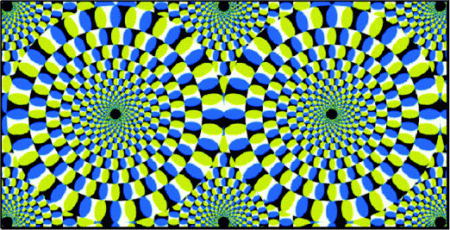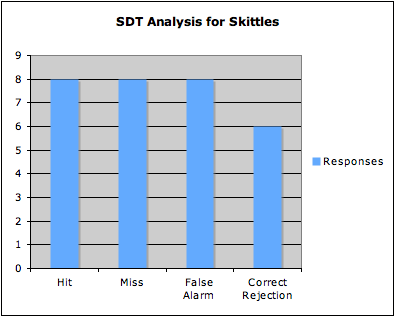For my final blog entry I chose to write on the phenomenon of synesthesia which I saw as the most interesting and surprising condition that I encountered during the semester. I had before seen cartoons and other such things on television portraying the senses and symptoms produced by synesthesia but never realized that the condition actually existed. Before having relevant knowledge of the condition, the symptoms produced by the synesthete I would believe could only be explained through the use of hallucinogenic drugs. Thus, the fact that the condition is actually produced by the body’s own sensory system and cognitive faculty without the use of such stimulants makes synesthesia a truly remarkable phenomenon. As a result, I did some research on the condition with much of the information provided coming from the book Synesthesia: A Union of the Senses by Richard Cytowic.
Synesthesia derives its name from the Ancient Greek (syn), which means “with,” and (aisthēsis), meaning “sensation.” The condition is neurologically-based in which stimulation of one sensory or cognitive pathway causes an involuntary, separate response in another sensory or cognitive pathway. Historically, although synesthesia has been known for about 300 years, there has been little research on the condition because the sciences of psychology and neurology have only begun to bloom in their own respects within the last 70 or so years. Only in recent years has cognition been associated brain function. Currently there are 54 known types of synesthesia, each shown in the chart below which was given in a lecture given by Professor Leanne Boucher.
One type of synesthesia, called color graphemic synesthesia, is characterized by people seeing colors when looking at letters or numbers. In another subform of graphemic synesthesia, ordinal linguistic personification, numbers, days, or months produce personalities. It is noted that there are many variations in the senses produced. For example, one synesthete may “have a highly restricted form of colored hearing, for
example, in which only a particular voice or particular kind of music
will elicit photisms. The opposite extreme is the pentamodal patient:
stimulation of one sense causes synesthesia in the remaining four” (Cytowic, Section 2). However, just by viewing the graph above one can determine the characteristic of each type of synesthesia and also determine the percentage of the prevalence that each form occurs.
Cytowic notes that in most instances the features of synesthesia have been present in a patient as far back as the patient can remember. Even as young children these synesthetes are able to realize that their perceptual world is markedly different from that of others. Also, many times these people keep their special symptoms to themselves believing that if they shared the story of their condition with others that they would be teased because others would not believe them. Synesthesia also brings with it psychological influences that can greatly affect the personalities of its subjects. However, it is also noted that although the condition brings with it many burdens, most synesthetes would not trade their abnormal senses for those of normal individuals. They, in turn, believe their perceptions to be real as their symptoms remain with them their entire lives.
In his book, Cytowic also gives personal accounts of the experiences of a number of synesthetes. Below is two such examples given from patient MN and patient OM.
Patient MN: “I remember most accurately scents. We were preparing to move into the house I grew up in. I remember at age 2 my father was on a ladder painting the
left side of the wall. The paint smelled blue, although he was painting it white. I
remember to this day thinking why the paint was white, when it smelled blue” (Cytowic, Section 2.1).
Patient OM: “Colors are very important to me because I have a gift—it’s not my fault, it’s just how I am—whenever I hear music, or even if I read music, I see colors” (Cytowic, Section 2.1).
Cytowic writes that when he encountered his first synesthete patient in 1979 that the interest in the condition was almost nonexistent. At this time he was criticized by his colleagues telling him that he was wasting his time and that he would likely ruin his career by focusing on such a bizarre condition. Since then he acknowledges that scientists in 13 countries have begun to show interest and investigate different aspects of synesthesia. Along with the increased interest in perceptual synesthesia, there has also begun a growing interest in metaphoric, or historical, synesthesia which can be seen by the number of research and encyclopedia pertaining to the subject. Currently, there are only three scientists predominately involved in the research of the condition. “They are Simon Baron-Cohen, an experimental psychologist in England; Hinderk Emrich, a philosopher turned psychiatrist and head of the clinical psychiatry department at the medical school in Hannover, Germany; and [Cytowic], an American neurologist and neuropsychologist (with a smidgen of British training)” (Cytowic, 3.1). Cytowic further notes that the three involved in the research of synesthesia each approach the condition in ways that are relevant to their basic fields of study.
Cytowic also lays out the diagnostic criteria that characterize idiopathic synesthesia which are discussed in his book. He also notes that these criteria help to distinguish idiopathic synesthesia from acquired synesthesia including drug-induced synesthesia, epileptic synesthesia, and that acquired through brain lesions. The criteria for this condition include:
- “Synesthesia is involuntary but elicited”
- ‘Synesthesia is spatially extended”
- “Synesthetic percepts are consistent and discrete”
- “Synesthesia is memorable”
- “Synesthesia is emotional”
The theories of the mechanism of synesthesia are grouped into the following categories:
1. Undifferentiated neuronal activity: sensory incontinence analogous
to synkinesis in infants
2. Linkage theories
a. Neural specificity
b. Polymodal combination
c. Vestigial connections, persisting from birth
3. Abstractions theories
a. Cognitive mediation
b. Aristotelian common sense (Cytowic, Section 3.4)
For the category of undifferentiated neuronal activity, previous beliefs theorized synesthesia’s cause to be linked to an immature nervous system and compared the condition to ordinary syn-kinesis, which is joined movements, seen in all infants. During syn-kinesis, movements in one area extend to other muscle groups. It is believed that this movement is not fixed until corticospinal and cerebellar motor pathways have matured and achieved thorough myelination. Cytowic states that this theory is labeled the degeneracy theory or compensation theory and further suggests that “synesthesia is a form of atavism or sensory incontinence” (Cytowic, Section 3.4.1). However, he also states that this theory is no longer seriously considered and proceeds to discuss the similarity of synesthesia to the gustofacial reflex, which is a “well-differentiated motor reaction of the facial muscles to taste stimuli” (Cytowic, Section 3.4.1). Comparisons of synesthesia and the gustofacial reflex suggest that the neural mechanism of synesthesia lies above the level of the brainstem.
The linkage theories of synesthesia suggest that there is a difference in the circuitry of synthetic brains compared to those on nonsynesthetes. Cytowic notes the significance of the synesthesia that occasionally occurs with LSD users and other anti-serotonergics since the hallucinations that are perceived by these individuals are assisted via sensory input from other modalities. Using LSD studies, it is also proposed that emotional meaning might be an appropriate linkage to the perceptions of synesthetes. Cytowic further notes that synesthetic patients are normally capable of making intermodal associations but that the difference lies with an additional binds to lead to perceptual experiences that are not additive but, instead, integrated. He also states that Emrich labels this hyperbinding. Citing a study by Maurer (1993), it also believed that if all neonates are synesthetic but lose their condition by 6 months of age then vestigial remnants could help explain synesthesia in these individuals in adulthood. Furthermore, citing the study of Paulesu and colleagues (1995), it is noted that cerebral metabolism is disturbed in synesthetic patients from what is expected in normal, nonsynesthetic individuals. Lastly, Cytowic admits that the question of “What is the nature of the proposed connection?” still remains. While Baren-Cohen propose corticocortical connections, Cytowic and Emrich support a vertical, lower-level linkage via corticolimbic projections.
The two main versions of the abstraction theory, cognitive mediation and Aristotelian common sense, both theorize a that there is a “filtering out” of certain sense elements that leave one with “an abstract emotional or an abstract perceptual residue that serves
as a synesthetic mediator” (Cytowic, Section 3.4.3). It is noted that in research done by Marks (1978), he believes synesthesia to be basically perceptual in nature and that such perception without language can still have meaning. Cytowic states that Marks has demonstrated that “even in cross-modal perception by nonsynesthetic persons, language only modulates but does not wholly mask or replace the underlying and prior sensory relations. In nonsynesthetic children, cross-modal similarities are stronger perceptually than verbally” (Cytowic, 3.4.3).
The emotional tone theory, which is still part of the abstraction theory, asserts that since synesthesia and its stimulus are common emotionally to the synesthete then the sensation produced should be one composed of responses from many of the senses and not just restricted to that of only one. However, this is not commonly seen is the responses seen in synesthetes.
Aristotelian common senses propose that the sensations produced through synesthesia are mediated through language. Thus, this theory suggests that synesthesia is more language-based and an more centered around metaphoric language than actual sensations. However, Cytowic claims that such “linguistic theories” are not correct. Finally, Cytowic states due to Aristotle’s common senses theory, research for the last 100 years has concentrated on shared meanings as the link to synesthesia and proposed that the condition took place at the highest levels of abstract processing in the central nervous system.
The information above is a just a dent in that provided on the many aspects of synesthesia. Synesthesia: A Union of the Senses supplies a great deal of more information that I have not listed and there are numerous other books in the Vanderbilt libraries as well as on the internet that can help better explain the phenomenon of synesthesia.
This is a painting by Jane Mackay titled “Tchaikovsky’s First Piano Concerto” which was created to portray a synesthetic composition that connect the senses of sight and sound.
This is to show an example of what a synesthete will experience. When looking at the picture above most people will see many 5’s and if they look longer will notice that some of the 5’s have been reversed to make 2’s. For someone with number-color synesthesia, they will immediately see a triangle of 2’s. The triangle would stand out because the 5’s and 2’s would both appear in different colors. Below is a portrayal of the picture to both a nonsynesthete and a synesthete.
(http://images.google.com/imgres?imgurl=http://www.youramazingbrain.org/images/brainchanges/synesthesia.gif&imgrefurl=http: //www.youramazingbrain.org/brainchanges/synesthesia.htm&h=320&w=320&sz=9&hl=en&start=4&tbnid=9l1yxQf-hBgGfM:&tbnh=118&tbnw=118&prev=/images%3Fq%3Dsynesthesia%26gbv%3D2%26hl%3Den)
A picture portraying what someone with color-number synesthesia may see when looking at a set of numbers.
WORKS CITED:
Cytowic, Richard E. Synesthesia: a Union of the Senses. 2nd ed. Cambridge, Mass.: MIT P, 2002.
http://en.wikipedia.org/wiki/Synesthesia
Randolph, Blake, and Sekuler Robert. Perception. 5th ed. Boston: McGraw Hill, 2006. 269-271.






 Figure: Subtractive Coloring
Figure: Subtractive Coloring Figure: Additive Coloring
Figure: Additive Coloring



